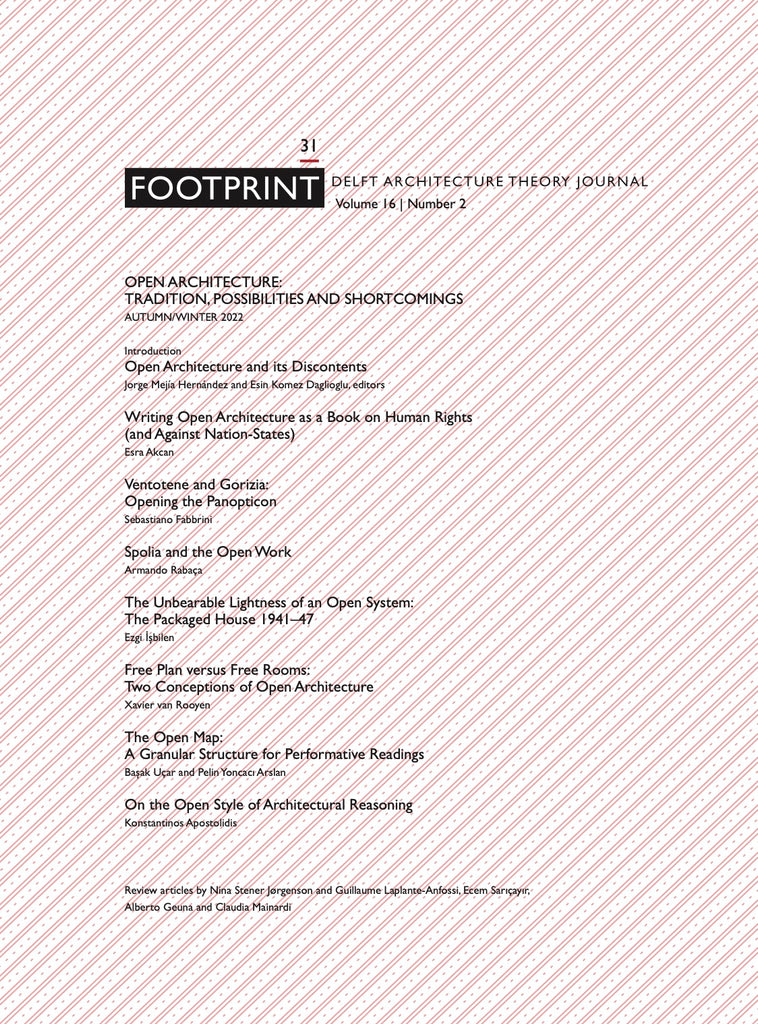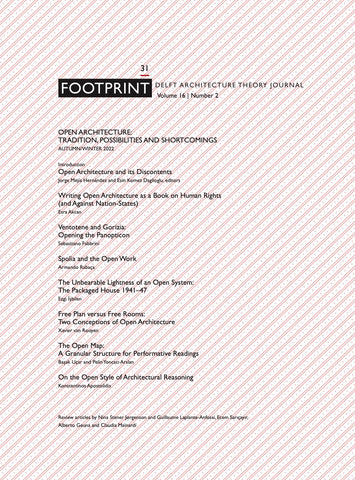Your cart is currently empty!
Architecture
Footprint 31 Open Architecture
+++Tradition, Possibilities, and Shortcomings+++
+++Jorge Mejía Hernández, Esin Komez Daglioglu [eds.]+++
English
Published in cooperation with Architecture Theory Chair (TU Delft) and Stichting Footprint: http://footprint.tudelft.nl/
For a subscription: Bruil & Van de Staaij
+++
| Footprint is a peer-reviewed architecture and theory academic journal
| An exploration of conceptual frameworks and methods of inquiry through critical and reflexive texts
Footprint 31 examines a number of ways in which architecture can be understood as open. Ranging from structural to procedural, and from performative to conceptual forms of openness, the articles collected in the issue elaborate on a diversity of open architectures of the past and present, in political, ideological, semiotic, technological, morphological, representational, and epistemological terms. Review articles provide further illustration by analysing three architectures by Nicolas Schöffer, Frank van Klingeren, and Lacaton and Vassal (with Jacques Hondelatte). The theoretical and methodological advantages and disadvantages of architectural openness identified by all contributors suggest alternative conceptualisations for the concept, and invite further reflection on the effectiveness and efficiency of its use towards the future.
Footprint is a peer-reviewed journal presenting academic research in the field of architecture theory. The journal encourages the study of architecture and the urban environment as a means of comprehending culture and society, and as a tool for relating them to shifting ideological doctrines and philosophical ideas. The journal promotes the creation and development – or revision – of conceptual frameworks and methods of inquiry. The journal is engaged in creating a body of critical and reflexive texts with a breadth and depth of thought which would enrich the architecture discipline and produce new knowledge, conceptual methodologies and original understandings. Footprint is grateful to our peer reviewers, who generously offered their time and expertise. In this issue, the following papers were peer-reviewed: ‘Architectures of Thought: Negentropy, Metabolics and the General Ephemeral’, ‘Forest Semiosis: Plant Noesis as Negentropic Potential’, ‘Being in the Hyper City, and the Posthuman Body’, ‘Transductive Architecture: What an Organology Produces – the Case of Le Corbusier’.
Tradition, Possibilities, and Shortcomings
€25.00
Footprint 31 Open Architecture
Tradition, Possibilities, and Shortcomings
€25.00
Architecture / Bookazines / Series / Theory / Urbanism
English
Published in cooperation with Architecture Theory Chair (TU Delft) and Stichting Footprint: http://footprint.tudelft.nl/
For a subscription: Bruil & Van de Staaij
| Footprint is a peer-reviewed architecture and theory academic journal
| An exploration of conceptual frameworks and methods of inquiry through critical and reflexive texts
Footprint 31 examines a number of ways in which architecture can be understood as open. Ranging from structural to procedural, and from performative to conceptual forms of openness, the articles collected in the issue elaborate on a diversity of open architectures of the past and present, in political, ideological, semiotic, technological, morphological, representational, and epistemological terms. Review articles provide further illustration by analysing three architectures by Nicolas Schöffer, Frank van Klingeren, and Lacaton and Vassal (with Jacques Hondelatte). The theoretical and methodological advantages and disadvantages of architectural openness identified by all contributors suggest alternative conceptualisations for the concept, and invite further reflection on the effectiveness and efficiency of its use towards the future.
Footprint is a peer-reviewed journal presenting academic research in the field of architecture theory. The journal encourages the study of architecture and the urban environment as a means of comprehending culture and society, and as a tool for relating them to shifting ideological doctrines and philosophical ideas. The journal promotes the creation and development – or revision – of conceptual frameworks and methods of inquiry. The journal is engaged in creating a body of critical and reflexive texts with a breadth and depth of thought which would enrich the architecture discipline and produce new knowledge, conceptual methodologies and original understandings. Footprint is grateful to our peer reviewers, who generously offered their time and expertise. In this issue, the following papers were peer-reviewed: ‘Architectures of Thought: Negentropy, Metabolics and the General Ephemeral’, ‘Forest Semiosis: Plant Noesis as Negentropic Potential’, ‘Being in the Hyper City, and the Posthuman Body’, ‘Transductive Architecture: What an Organology Produces – the Case of Le Corbusier’.









